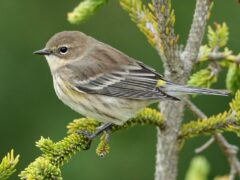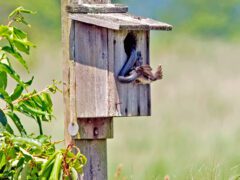The Four Keys to ID
- Size & Shape
Field Sparrows are small, slender sparrows with relatively short, conical bills, rounded heads, and somewhat long tails.
Relative Size
Smaller and more slender than a Song Sparrow; larger than a Black-capped or Carolina Chickadee.

 sparrow-sized or smaller
sparrow-sized or smallerMeasurements
- Both Sexes
- Length: 4.7-5.9 in (12-15 cm)
- Weight: 0.4-0.5 oz (11-15 g)
- Wingspan: 7.9 in (20 cm)
© Chris Thomas / Macaulay Library
- Color Pattern
- Behavior
- Habitat
Regional Differences
Field Sparrows in the Great Plains tend to be larger, paler, and grayer than their brighter, browner counterparts in the East, although there is considerable overlap in both plumage and size. On Great Plains individuals, the only warm body coloration is restricted to the crown (but with a gray central crown stripe) and a bar at the shoulder. The back is brown with gray streaks.


















































